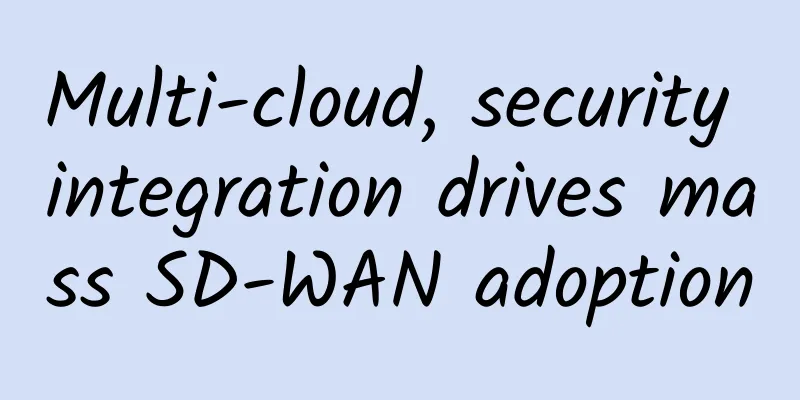Multi-cloud, security integration drives mass SD-WAN adoption

|
SD-WAN is expected to grow 40% year-over-year through 2022, driven by relationships between vendors such as Cisco, VMware, Juniper and Arista and service providers such as AWS, Microsoft Azure, Google Anthos and IBM RedHat. The increase in cloud adoption and improvements in network security, visibility, and manageability are driving the deployment of enterprise-class software-defined wide area networks (SD-WANs) at a rapid pace.
Rohit Mehra, vice president of network infrastructure at IDC, said that according to IDC research, software and infrastructure as a service (SaaS and IaaS) offerings have been driving SD-WAN implementations over the past year. For example, IDC said that its recent survey of customers showed that 95% of customers will use SD-WAN technology within two years, and 42% of customers have already deployed this technology. IDC also said that by 2022, the market size of SD-WAN infrastructure will reach $4.5 billion, and it will grow more than 40% per year between now and then. “The growth of SD-WAN is a broad trend that is driven primarily by enterprises looking to optimize cloud connectivity at remote sites,” Mehra said. In fact, the growth of multi-cloud networks is prompting many enterprises to re-adjust their networks to support SD-WAN technology, Cisco also wrote recently. SD-WAN is critical for enterprises adopting cloud services because it is the connective tissue between campus, branch offices, IoT, data centers and clouds. The company said that surveys show that Cisco customers have an average of 30 paid SaaS applications each. And they are actually using more devices, in some cases even more than 100. The trend is also driven in part by the relationships that networking vendors like Cisco, VMware, Juniper, Arista and others have built with companies like Amazon Web Services, Microsoft Azure, Google Anthos and IBM RedHat. Last December, AWS announced some key services in its cloud services, including new integration technologies such as AWS Transit Gateway, which allows customers to connect their Amazon virtual private cloud and their on-premises network to a single gateway, marking the growing importance of SD-WAN and hybrid cloud relationships. Aruba, Aviatrix Cisco, Citrix Systems, Silver Peak and Versa have announced support for the technology, which is expected to simplify and improve the performance of SD-WAN integration with AWS cloud resources. In the future, new features such as cloud-based application insights and performance monitoring will be a key part of SD-WAN rollouts, Mehra said. While the relationship between SD-WAN and the cloud is evolving, the need for integrated security features is also growing. "The way SD-WAN products integrate security is much better than the traditional way of protecting WAN traffic, which often involves separate packages and services," Mehra said. "SD-WAN is a much more flexible security environment." Security, analytics and WAN optimization will be seen as top SD-WAN components, with integrated security being the top requirement for next-generation SD-WAN solutions, Mehra said. Enterprises will look less and less at single-point SD-WAN solutions and will lean more toward platforms that can address broader network management and security needs, Mehra said. They will look for SD-WAN platforms that can integrate with other aspects of their IT infrastructure, such as a company's data center network, an enterprise campus LAN or public cloud resources, he said. They will look for security services, as well as support for a variety of additional features, such as visibility, analytics and unified communications. “As customers continue to integrate their infrastructure components with the software, they can achieve consistent management and security policies based on user, device or application needs across LANs and WANs and ultimately achieve a better overall application experience,” Mehra said. An emerging trend is the need to use SD-WAN packages to support SD-branch technology. Mehra said that more than 70% of IDC's surveyed customers expect to use SD-Branch technology within the next year. In recent weeks, Juniper and Aruba have also enhanced SD-Branch capabilities, and this trend is expected to continue this year. SD-Branch builds on the concepts and support of SD-WAN, but is more specifically targeted at the networking and management needs of the LAN in the branch. Looking ahead, how SD-Branch will integrate other technologies such as analytics, voice, unified communications and video will be a key driver of the technology. |
Recommend
NEC successfully achieves world-leading 800 Gbps long-distance transmission with submarine optical cable
NEC has successfully conducted a long-distance fi...
One year later than expected! The global microwave transmission market is expected to enter a multi-year growth period in 2021
Recently, Jimmy Yu, vice president and analyst at...
How SD-WAN as a Service Addresses MPLS Limitations
While MPLS has served enterprises well for many y...
There are about 180 million users of 5G packages using 4G terminals
Recently, the net increase in 5G package users of...
Confirmed! Can you still access the 5G network without a 5G package? The deduction rules have been released
Expensive 5G plans After entering 2020, 5G has be...
The world's first! H3C is the first to pass the "IPv6+Ready 2.0 & SRv6 Ready" certification
Recently, several high-end core routers and WAN c...
What does the expansion of 4G mean for big data?
As the market share of smartphones continues to g...
5G is evolving to be more secure than 4G
Some people say that 5G network speed is 10-100 t...
5G, why not completely jointly build and share wireless access networks?
The key to 5G is to provide diversified services ...
Gcore (gcorelabs) Japanese VPS simple test
The tribe has shared G-core product information s...
E-commerce past | Farewell to public domain traffic
[[420018]] It is not difficult to see that 2020 i...
6 steps to effective real-time monitoring across hybrid IT
For data center operations, it can be difficult t...
In 2020, who will break out in the 5G era?
In June 2019, the Ministry of Industry and Inform...
Let JWT protect your API services
Hello everyone, I am Dayao. I have written an art...









